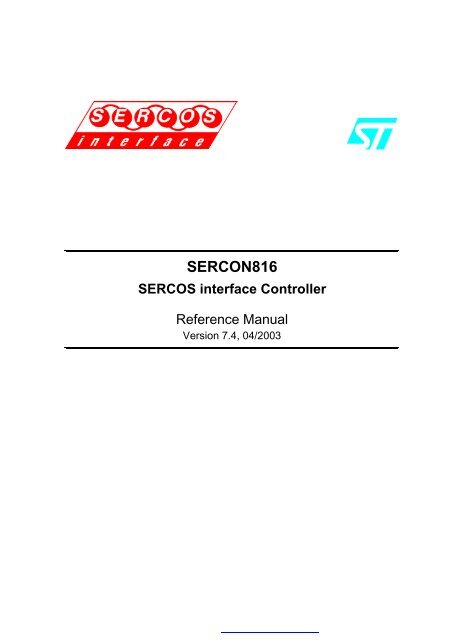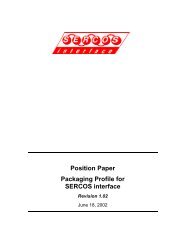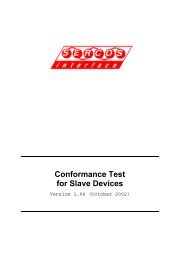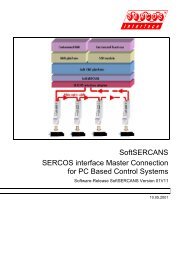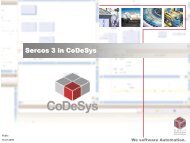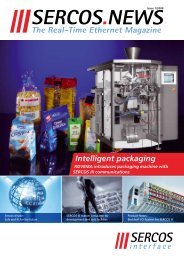SERCON816 SERCOS interface Controller
SERCON816 SERCOS interface Controller
SERCON816 SERCOS interface Controller
Create successful ePaper yourself
Turn your PDF publications into a flip-book with our unique Google optimized e-Paper software.
<strong>SERCON816</strong><br />
<strong>SERCOS</strong> <strong>interface</strong> <strong>Controller</strong><br />
Reference Manual<br />
Version 7.4, 04/2003
Project: <strong>SERCON816</strong><br />
Document Type Reference Manual<br />
File: <strong>SERCON816</strong>man-v7_4.doc<br />
Version Date Remarks<br />
08/99 August 24, 1999 Preliminary edition<br />
Version<br />
01/2000<br />
October 12, 1999<br />
November 5, 1999<br />
Add Nandtree Description<br />
Final modifications (TWG)<br />
04/2000 April 2000 Editorial correction, setup time, hold time<br />
10/2000 October 2000 New Fig. 17: Data and clock regeneration<br />
07/2001 July 2001 Table of MCLK, current consumption<br />
October 2001 Clear Interrupt Timing (WRN -> INT 0/1)<br />
02/2002 February 4, 2002 correction for RegMode=1<br />
09/2002 September 24, 2002 TQFP Packaging mechanical information removed<br />
Correction Fig. 48 (Missing sync telegrams)<br />
01/2003 January 2003 Fig. 19 Transmitter circuit<br />
TxD6-1, peak / static output current<br />
7.4 April 2003 Chapter G: Troubleshooting added<br />
Correction of BUSYN Timing Description (page 23)<br />
The Interests Group <strong>SERCOS</strong> <strong>interface</strong> e. V. is not liable for any errors in this<br />
documentation. Liability for direct and indirect damages arising in connection with the<br />
supply of this documentation is excluded in so far as it can be attached legally.<br />
This documentation contains copyright-protected information.<br />
All rights, especially the right of duplication, distribution and translation, are reserved. No<br />
portion of the documentation may be reproduced, copied or distributed in any form<br />
(photocopy, microfilm or other process) without advance written permission of the<br />
Interests Group <strong>SERCOS</strong> <strong>interface</strong> e. V.<br />
Published by<br />
Interests Group <strong>SERCOS</strong> <strong>interface</strong> e. V.<br />
Landhausstr. 20<br />
D - 70190 Stuttgart, Germany<br />
Phone: +49(0)711-28457-50<br />
Fax: +49(0)711-28457-55<br />
E-Mail: info@sercos.de
ADMUX<br />
BUSMODE[1:0]<br />
BUSWIDTH<br />
BYTEDIR<br />
SBAUD<br />
SBAUD16<br />
TM0/1<br />
WRN D[15:0] A[15:0] BUSYN<br />
RDN<br />
bus <strong>interface</strong><br />
telegramprocessing<br />
RxC<br />
RxD<br />
ALEL<br />
ALEH BHEN<br />
timingcontrol<br />
serial <strong>interface</strong><br />
TxC<br />
TxD[6:1]<br />
clock<br />
reset<br />
watchdog<br />
General description<br />
<strong>SERCON816</strong> Reference Manual 3<br />
V7.4 (04/2003)<br />
DMA<br />
MCSN0/1<br />
PCSN0<br />
PCS1<br />
optical transmitter/<br />
receiver or<br />
RS-485 bus drive<br />
interrupt<br />
Fig. 1: <strong>SERCON816</strong> block diagram<br />
<strong>SERCOS</strong> <strong>interface</strong> controller <strong>SERCON816</strong><br />
INT0/1<br />
SCLK<br />
SCLKO2/4<br />
MCLK<br />
RSTN<br />
DMAREQR/T<br />
DMAACKNR/T<br />
WDOGN<br />
CYC_CLK<br />
CON_CLK<br />
DIV_CLK<br />
L_ERRN<br />
RECACTN<br />
IDLE<br />
SERCBL.CDR<br />
· Single-chip controller for <strong>SERCOS</strong> <strong>interface</strong><br />
· Real time communication for industrial control systems<br />
· 8/16-bit bus <strong>interface</strong>, Intel and Motorola control signals<br />
· Dual port RAM with 2048 words * 16-bit<br />
· Data communications via optical fiber rings, RS 485 rings and RS 485 busses<br />
· Maximum transmission rate of 16 Mbaud with internal clock recovery<br />
· Internal repeater for ring connections<br />
· Full duplex operation<br />
· Modulation of power of optical transmitter diode<br />
· Automatic transmission of synchronous and data telegrams in the communication<br />
cycle<br />
· Flexible RAM configuration, communication data stored in RAM (single or<br />
double buffer) or transfer via DMA<br />
· Synchronization by external signal<br />
· Timing control signals<br />
· Automatic service channel transmission<br />
· Watchdog<br />
· Compatible mode to SERCON410B <strong>SERCOS</strong> <strong>interface</strong> controller<br />
· 100-pin plastic flat-pack casing
General description<br />
A.1.1 Table of contents<br />
A.1.1 Table of contents 6<br />
A.1.2 Table of figures 9<br />
1 GENERAL DESCRIPTION 13<br />
2 PIN DESCRIPTION 15<br />
3 MICROPROCESSOR INTERFACE 19<br />
3.1 MICROPROCESSOR BUS INTERFACE 19<br />
3.1.1 Address and data bus 19<br />
3.1.2 Chip select signals 20<br />
3.1.3 Bus control signals 20<br />
3.1.4 8-bit bus mode 21<br />
3.1.5 16-bit bus mode 22<br />
3.1.6 Dual port RAM arbitration 22<br />
3.2 INTERRUPTS 24<br />
3.3 DMA INTERFACE 28<br />
3.4 RESET AND POWER-DOWN 30<br />
3.5 CLOCK 32<br />
3.6 CONTROL OF DOUBLE BUFFER (VAL BIT) 32<br />
4 SERIAL INTERFACE 35<br />
4.1 CLOCK AND DATA REGENERATION 36<br />
4.1.1 Internal clock regeneration 36<br />
4.2 REPEATER 39<br />
4.3 SERIAL OUTPUTS TXD1-6 40<br />
4.4 SERIAL TRANSMITTING 41<br />
4.5 SERIAL RECEIVING 42<br />
4.6 TEST SIGNAL GENERATOR AND SIGNAL MONITORING 43<br />
5 TELEGRAM PROCESSING 45<br />
5.1 <strong>SERCOS</strong> INTERFACE PRINCIPLES 45<br />
5.1.1 Cyclic transmission of telegrams 45<br />
5.1.2 Telegram structure 46<br />
5.1.3 Service channel transmission 47<br />
5.1.4 <strong>SERCOS</strong> <strong>interface</strong> initialization 49<br />
5.1.5 <strong>SERCON816</strong> operating modes 50<br />
5.2 <strong>SERCOS</strong> INTERFACE MASTER OPERATION 52<br />
5.2.1 Timing control 52<br />
5.2.2 Transmission of data telegrams 62<br />
5.2.3 Service channel transmission 74<br />
5.3 <strong>SERCOS</strong> INTERFACE SLAVE OPERATION 83<br />
5.3.1 Timing control 83<br />
5.3.2 Transmission of data telegrams 90<br />
5.3.3 Service channel transmission 102<br />
5.4 NON-<strong>SERCOS</strong> INTERFACE OPERATION 109<br />
5.4.1 Timing control 109<br />
5.4.2 Telegram processing 110<br />
5.4.3 Service channel transmission 110<br />
5.5 WATCHDOG 111<br />
5.5.1 Watchdog enable 112<br />
5.5.2 Trigger interval 112<br />
5.5.3 Trigger by software 112<br />
5.5.4 Trigger by start of MST 112<br />
5.5.5 Watchdog interrupt 113<br />
5.5.6 Watchdog output WDOGN 113<br />
6 Reference Manual <strong>SERCON816</strong><br />
V7.4 (04/2003)
General description<br />
5.5.7 Control of internal telegram processing 113<br />
A CONTROL REGISTERS AND RAM DATA STRUCTURES 115<br />
A.1 CONTROL REGISTER ADDRESSES 115<br />
A.2 DATA STRUCTURES WITHIN THE RAM 121<br />
A.2.1 Telegram headers 121<br />
A.2.2 Data containers 122<br />
A.2.3 End marker 123<br />
A.2.4 Service containers 123<br />
B PROGRAMMING EXAMPLE 127<br />
B.1 MASTER PROGRAMMING 127<br />
B.1.1 Control registers 128<br />
B.1.2 RAM data structures 129<br />
B.1.3 Service channel transmission 131<br />
B.2 SLAVE PROGRAMMING 134<br />
B.2.1 Control registers 134<br />
B.2.2 RAM data structures 135<br />
B.2.3 Service channel transmission 137<br />
C DC AND AC CHARACTERISTICS 142<br />
C.1 ABSOLUTE MAXIMUM RATINGS 142<br />
C.2 RECOMMENDED OPERATING CONDITIONS 142<br />
C.3 DC ELECTRICAL CHARACTERISTICS 142<br />
C.4 POWER DISSIPATION 143<br />
C.4.1 Power Dissipation Considerations 144<br />
C.5 AC ELECTRICAL CHARACTERISTICS 144<br />
C.5.1 Clock input MCLK 145<br />
C.5.2 Clock input SCLK 145<br />
C.5.3 Address latch 146<br />
C.5.4 Read access of control registers 147<br />
C.5.5 Read access of dual port RAM 148<br />
C.5.6 Write access to control registers 149<br />
C.5.7 Write access to dual port RAM 150<br />
C.5.8 BUSYN timing 151<br />
D MECHANICAL DATA 152<br />
E REPLACE SERCON410B BY <strong>SERCON816</strong> 155<br />
E.1 PINNING 155<br />
E.2 SERIAL INTERFACE 156<br />
E.3 REPEATER RESET MODE 157<br />
E.4 TELEGRAM PROCESSING 157<br />
E.4.1 Speed of telegram processing 157<br />
E.4.2 Bug-fix PHAS12 157<br />
E.4.3 New interrupt INT_RSCEND 158<br />
E.4.4 Control of double buffer (VAL bit) 158<br />
E.5 DUAL PORT RAM 159<br />
E.6 WATCHDOG 160<br />
E.7 CONTROL REGISTERS 160<br />
F INTEGRATED CIRCUIT TEST (NANDTREE) 161<br />
F.1 NANDTREE USE FOR IN-CIRCUIT-TEST 161<br />
G TROUBLESHOOTING 162<br />
G.1 DATA CORRUPTION IN CYCLIC TELEGRAM 162<br />
G.2 MDT TELEGRAM TOO LONG 162<br />
G.3 SPORADIC LOSS OF <strong>SERCOS</strong> IRQ 162<br />
<strong>SERCON816</strong> Reference Manual 7<br />
V7.4 (04/2003)
A.1.2 Table of figures<br />
General description<br />
Fig. 1: <strong>SERCON816</strong> block diagram .................................................................................................................. 3<br />
Fig. 2: <strong>SERCON816</strong> with ring connection (<strong>SERCOS</strong> <strong>interface</strong> )................................................................. 11<br />
Fig. 3: <strong>SERCON816</strong> with RS-485 bus connection.......................................................................................... 11<br />
Fig. 4: <strong>SERCON816</strong> pin configuration ........................................................................................................... 14<br />
Fig. 5: Multiplexed address/data bus ............................................................................................................... 19<br />
Fig. 6: Chip select signals................................................................................................................................ 20<br />
Fig. 7: Bus control signals according to Intel standard.................................................................................... 21<br />
Fig. 8: Bus control signals according to Motorola standard ............................................................................ 21<br />
Fig. 9: Reading the dual port RAM ................................................................................................................. 23<br />
Fig. 10: Writing the dual port RAM ................................................................................................................ 23<br />
Fig. 11: Block diagram of interrupt logic ........................................................................................................ 24<br />
Fig. 12: DMA transfer during telegram receiving ........................................................................................... 28<br />
Fig. 13: DMA transfer during DMA transmitting ........................................................................................... 29<br />
Fig. 14: Clock inputs and outputs .................................................................................................................... 32<br />
Fig. 15: Forbidden time slot for programming VAL ....................................................................................... 33<br />
Fig. 16: Serial <strong>interface</strong> with internal clock and data regeneration.................................................................. 35<br />
Fig. 17: Data and clock regeneration ............................................................................................................... 37<br />
Fig. 18: Switchover between repeater and telegram........................................................................................ 39<br />
Fig. 19: Connecting the optical transmitter to TxD1-6 (TXDMODE = 0) ...................................................... 40<br />
Fig. 20: Serial transmitter timing..................................................................................................................... 41<br />
Fig. 21: Serial receiver timing ......................................................................................................................... 42<br />
Fig. 22: <strong>SERCOS</strong> <strong>interface</strong> communication cycle....................................................................................... 45<br />
Fig. 23: <strong>SERCOS</strong> <strong>interface</strong> telegram structure ............................................................................................ 46<br />
Fig. 24: Write operation of service channel..................................................................................................... 47<br />
Fig. 25: Read operation of service channel...................................................................................................... 48<br />
Fig. 26: Telegrams during initialization .......................................................................................................... 49<br />
Fig. 27: Triggering of three MST cycles via falling edge of CYC_CLK ........................................................ 53<br />
Fig. 28: Start of communication cycle too early and too late .......................................................................... 56<br />
Fig. 29: Receiving the MST by the master ...................................................................................................... 57<br />
Fig. 30: Telegram times................................................................................................................................... 58<br />
Fig. 31: Time interrupts and output signals CON_CLK and DIV_CLK ......................................................... 60<br />
Fig. 32: DIV_CLK in mode DIVCLKMODE=1............................................................................................. 62<br />
Fig. 33: Master data blocks.............................................................................................................................. 64<br />
Fig. 34: Flowchart of telegram processing (master) ........................................................................................ 65<br />
Fig. 35: Telegram processing in the master ..................................................................................................... 66<br />
Fig. 36: Processing of receive telegrams ......................................................................................................... 67<br />
Fig. 37: Receiving a data telegram .................................................................................................................. 70<br />
Fig. 38: Processing of transmit telegrams........................................................................................................ 72<br />
Fig. 39: Master data telegram with data records for 4 slaves .......................................................................... 73<br />
Fig. 40: Transmitting a data telegram.............................................................................................................. 74<br />
Fig. 41: Automatic service channel transmission of master ............................................................................ 75<br />
Fig. 42: Service container construction ........................................................................................................... 76<br />
Fig. 43: Service channel write operation of master ......................................................................................... 79<br />
Fig. 44: Service channel read operation of master........................................................................................... 81<br />
Fig. 45: Interrupt RSCEND ............................................................................................................................. 82<br />
Fig. 46: Receiving the MST in the slave ......................................................................................................... 84<br />
Fig. 47: Receiving the MST too early ............................................................................................................. 87<br />
Fig. 48: Master sync telegrams missing .......................................................................................................... 87<br />
Fig. 49: Telegram time slots in the slave ......................................................................................................... 88<br />
Fig. 50: Slave data block ................................................................................................................................. 90<br />
Fig. 51: Flowchart of telegram processing (slave)........................................................................................... 91<br />
Fig. 52: Transmission blocks in the slave........................................................................................................ 91<br />
Fig. 53: Processing of transmit telegrams (slave)............................................................................................ 94<br />
Fig. 54: Handling of control bit FLADRMDT ................................................................................................ 95<br />
<strong>SERCON816</strong> Reference Manual 9<br />
V7.4 (04/2003)
General description<br />
Fig. 55: Processing of receive telegrams (slave) .............................................................................................. 97<br />
Fig. 56: Receive of two data records of MDT..................................................................................................98<br />
Fig. 57: Slave operation during phase 1 and 2 .................................................................................................99<br />
Fig. 58: Automatic service channel transmission of slave .............................................................................102<br />
Fig. 59: Service container construction..........................................................................................................103<br />
Fig. 60: Service channel operation of slave....................................................................................................106<br />
Fig. 61: Watchdog operation ..........................................................................................................................111<br />
Fig. 62: Watchdog trigger by MST ................................................................................................................113<br />
Fig. 63: Reset microprocessor by WDOGN...................................................................................................113<br />
Fig. 64: Structure of data containers ..............................................................................................................122<br />
Fig. 65: Structure of service container ...........................................................................................................123<br />
Fig. 66: Example of service channel transmission (master)...........................................................................131<br />
Fig. 67: Example of service channel transmission (slave) .............................................................................137<br />
Fig. 68: Timing of clock MCLK and related outputs .....................................................................................145<br />
Fig. 69: Timing of clock SCLK .....................................................................................................................145<br />
Fig. 70: Address latch ....................................................................................................................................146<br />
Fig. 71: Read access of control registers ........................................................................................................147<br />
Fig. 72: Read access of dual port RAM .........................................................................................................148<br />
Fig. 73: Write access to control registers .......................................................................................................149<br />
Fig. 74: Write access to dual port RAM.........................................................................................................150<br />
Fig. 75: BUSYN Timing ................................................................................................................................ 151<br />
Fig. 76: PQFP-100 mechanical data...............................................................................................................152<br />
Fig. 77: Handling of control bit FLADRMDT ............................................................................................... 158<br />
Fig. 78: Forbidden time slot for programming VAL......................................................................................159<br />
Fig. 79: Nandtree............................................................................................................................................161<br />
10 Reference Manual <strong>SERCON816</strong><br />
V7.4 (04/2003)


